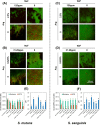Combinatorial effects of arginine and fluoride on oral bacteria
- PMID: 25477312
- PMCID: PMC4438734
- DOI: 10.1177/0022034514561259
Combinatorial effects of arginine and fluoride on oral bacteria
Abstract
Dental caries is closely associated with the microbial disequilibrium between acidogenic/aciduric pathogens and alkali-generating commensal residents within the dental plaque. Fluoride is a widely used anticaries agent, which promotes tooth hard-tissue remineralization and suppresses bacterial activities. Recent clinical trials have shown that oral hygiene products containing both fluoride and arginine possess a greater anticaries effect compared with those containing fluoride alone, indicating synergy between fluoride and arginine in caries management. Here, we hypothesize that arginine may augment the ecological benefit of fluoride by enriching alkali-generating bacteria in the plaque biofilm and thus synergizes with fluoride in controlling dental caries. Specifically, we assessed the combinatory effects of NaF/arginine on planktonic and biofilm cultures of Streptococcus mutans, Streptococcus sanguinis, and Porphyromonas gingivalis with checkerboard microdilution assays. The optimal NaF/arginine combinations were selected, and their combinatory effects on microbial composition were further examined in single-, dual-, and 3-species biofilm using bacterial species-specific fluorescence in situ hybridization and quantitative polymerase chain reaction. We found that arginine synergized with fluoride in suppressing acidogenic S. mutans in both planktonic and biofilm cultures. In addition, the NaF/arginine combination synergistically reduced S. mutans but enriched S. sanguinis within the multispecies biofilms. More importantly, the optimal combination of NaF/arginine maintained a "streptococcal pressure" against the potential growth of oral anaerobe P. gingivalis within the alkalized biofilm. Taken together, we conclude that the combinatory application of fluoride and arginine has a potential synergistic effect in maintaining a healthy oral microbial equilibrium and thus represents a promising ecological approach to caries management.
Keywords: Porphyromonas gingivalis; Streptococcus mutans; Streptococcus sanguis; biofilms; dental caries; drug synergism.
© International & American Associations for Dental Research 2014.
Conflict of interest statement
The authors declare no potential conflicts of interest with respect to the authorship and/or publication of this article.
Figures





Similar articles
-
Effects of Antimicrobial Peptide GH12 on the Cariogenic Properties and Composition of a Cariogenic Multispecies Biofilm.Appl Environ Microbiol. 2018 Nov 30;84(24):e01423-18. doi: 10.1128/AEM.01423-18. Print 2018 Dec 15. Appl Environ Microbiol. 2018. PMID: 30341079 Free PMC article.
-
Ecological Effect of Arginine on Oral Microbiota.Sci Rep. 2017 Aug 3;7(1):7206. doi: 10.1038/s41598-017-07042-w. Sci Rep. 2017. PMID: 28775282 Free PMC article.
-
Effects of glucose and fluoride on competition and metabolism within in vitro dental bacterial communities and biofilms.Caries Res. 2002 Mar-Apr;36(2):81-6. doi: 10.1159/000057864. Caries Res. 2002. PMID: 12037363
-
The Anticaries Efficacy of a 1.5% Arginine and Fluoride Toothpaste.Adv Dent Res. 2018 Feb;29(1):93-97. doi: 10.1177/0022034517735298. Adv Dent Res. 2018. PMID: 29355420 Review.
-
Biofilm plaque and hydrodynamic effects on mass transfer, fluoride delivery and caries.J Am Dent Assoc. 2008 Sep;139(9):1182-90. doi: 10.14219/jada.archive.2008.0333. J Am Dent Assoc. 2008. PMID: 18762628 Review.
Cited by
-
The Effects of Nonnutritive Sweeteners on the Cariogenic Potential of Oral Microbiome.Biomed Res Int. 2021 Jun 24;2021:9967035. doi: 10.1155/2021/9967035. eCollection 2021. Biomed Res Int. 2021. PMID: 34258285 Free PMC article.
-
Effect of Cavity Cleanser With Long-Term Antibacterial and Anti-Proteolytic Activities on Resin-Dentin Bond Stability.Front Cell Infect Microbiol. 2021 Nov 19;11:784153. doi: 10.3389/fcimb.2021.784153. eCollection 2021. Front Cell Infect Microbiol. 2021. PMID: 34869081 Free PMC article.
-
The combined antimicrobial effect of arginine and fluoride toothpaste.Sci Rep. 2019 Jun 10;9(1):8405. doi: 10.1038/s41598-019-44612-6. Sci Rep. 2019. PMID: 31182718 Free PMC article.
-
Effect of a novel synbiotic on Streptococcus mutans.Sci Rep. 2020 May 14;10(1):7951. doi: 10.1038/s41598-020-64956-8. Sci Rep. 2020. PMID: 32409686 Free PMC article.
-
Combined effect of arginine and fluoride on the growth of Lactobacillus rhamnosus GG.Sci Rep. 2021 Jan 13;11(1):973. doi: 10.1038/s41598-020-79684-2. Sci Rep. 2021. PMID: 33441658 Free PMC article.
References
-
- Acevedo AM, Machado C, Rivera LE, Wolff M, Kleinberg I. 2005. The inhibitory effect of an arginine bicarbonate/calcium carbonate CaviStat-containing dentifrice on the development of dental caries in Venezuelan school children. J Clin Dent. 16(3):63–70. - PubMed
-
- Acevedo AM, Montero M, Rojas-Sanchez F, Machado C, Rivera LE, Wolff M, Kleinberg I. 2008. Clinical evaluation of the ability of CaviStat in a mint confection to inhibit the development of dental caries in children. J Clin Dent. 19(1):1–8. - PubMed
-
- Burne RA, Marquis RE. 2000. Alkali production by oral bacteria and protection against dental caries. FEMS Microbiol Lett. 193(1):1–6. - PubMed
-
- Featherstone JD. 2009. Remineralization, the natural caries repair process—the need for new approaches. Adv Dent Res. 21(1):4–7. - PubMed
Publication types
MeSH terms
Substances
LinkOut - more resources
Full Text Sources
Other Literature Sources

